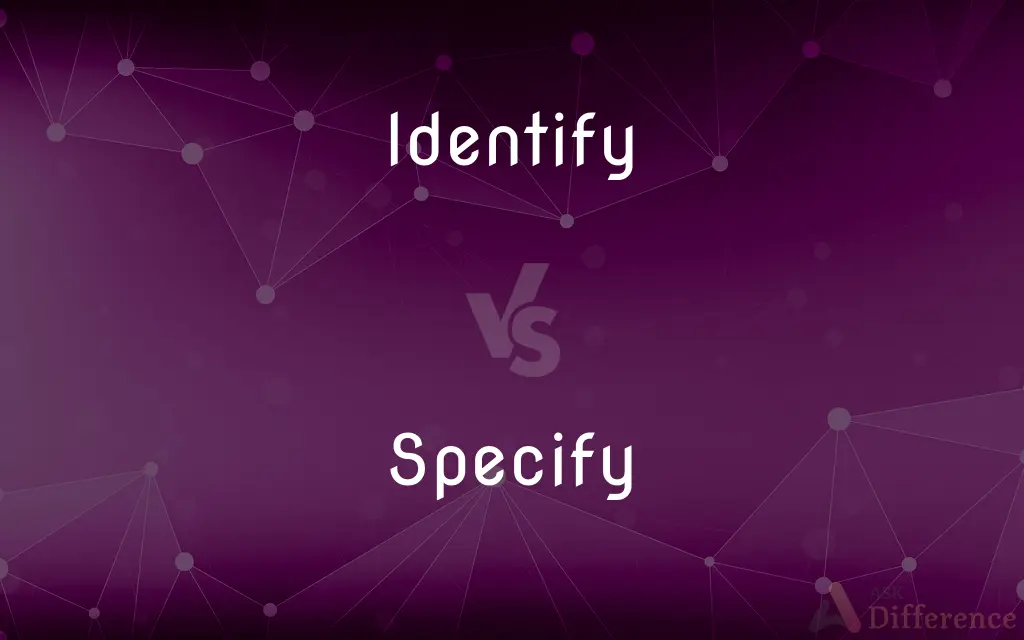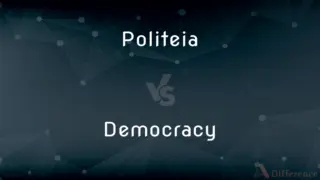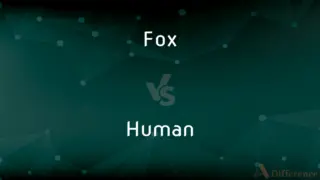Identify vs. Specify — What's the Difference?
By Maham Liaqat & Fiza Rafique — Updated on March 20, 2024
Identify involves recognizing and naming, while specify involves providing detailed information or requirements.

Difference Between Identify and Specify
Table of Contents
ADVERTISEMENT
Key Differences
Identifying is the process of recognizing and naming someone or something from among others. It involves distinguishing characteristics that set the subject apart, making it possible to recognize it in the future. On the other hand, specifying is about providing detailed information or stating exactly what is required or desired, often in the context of instructions, requirements, or characteristics.
When you identify something, you are essentially picking it out from a group based on its defining features or characteristics. This could involve recognizing a species of plant from its leaves, identifying a genre of music from its sound, or recognizing a problem from its symptoms. Whereas specifying something goes a step further by detailing particular attributes, measurements, conditions, or criteria that something must meet or possess.
Identification can be seen as the first step in many processes, where recognizing and naming something sets the stage for further action or analysis. For example, identifying a type of chemical in a sample might be the first step before specifying the concentration levels needed for a particular experiment. In contrast, specifying usually follows identification and involves defining precise parameters, such as dimensions, quality standards, or specific requirements that guide production, design, or selection processes.
The tools and methods used in identification and specification can vary widely. Identification might rely on visual cues, patterns, or diagnostic tests, while specifying often involves numerical data, technical descriptions, and detailed documentation. For instance, biologists use identification keys to determine the species of organisms, whereas engineers specify the materials, dimensions, and tolerances needed for manufacturing components.
In everyday language, the distinction between identifying and specifying can also be seen in how we communicate needs or requirements. Saying, "I identified the problem with the computer as a faulty hard drive," focuses on recognizing the issue. In contrast, specifying would involve stating the exact type of replacement drive needed, such as, "We need a 1TB SSD with a read speed of 550MB/s."
ADVERTISEMENT
Comparison Chart
Purpose
To recognize and name
To provide detailed information or requirements
Focus
Distinguishing characteristics
Detailed attributes, measurements, or criteria
Process
Recognition and naming
Detailing precise parameters or conditions
Application
Sets the stage for further analysis or action
Guides production, design, or selection processes
Examples
Identifying a bird species by its song
Specifying the dimensions for a custom shelf
Compare with Definitions
Identify
Essential for diagnosis or problem-solving.
The mechanic identified the noise as coming from the engine.
Specify
Guides the selection or manufacturing process.
The engineer specified a high-performance alloy for the new design.
Identify
The first step in many analytical processes.
The first task is to identify the main themes of the text.
Specify
To state or describe in detail.
The architect specified the materials for the building project.
Identify
To recognize or distinguish from others.
Scientists identified a new species in the rainforest.
Specify
Essential for precision and clarity in communication.
Please specify your dietary restrictions when making a reservation.
Identify
Can be based on visual, auditory, or other sensory cues.
She identified her friend in the crowd by her distinctive laugh.
Specify
Used in defining parameters or criteria.
The recipe specifies exactly how much sugar to use.
Identify
Involves naming or classifying based on characteristics.
The app helps users identify stars and planets in the night sky.
Specify
Involves setting out requirements or conditions.
The contract specifies the deadlines for each phase of work.
Identify
To establish or recognize the identity of; ascertain as a certain person or thing
Can you identify what kind of plane that is? I identified the man at the next table as a famous actor.
Specify
To state explicitly or in detail
Specified the amount needed.
Specified what was wrong with the program.
Identify
(Biology) To determine the taxonomic classification of (an organism).
Specify
To include in a specification.
Identify
To ascertain as having a certain characteristic or feature
Job candidates who are identified as overqualified.
Children who have been identified with hearing loss.
Specify
To determine or bring about (a specific result)
A gene that specifies the synthesis of a single protein.
Identify
To consider as identical or united; equate
The Greek god Ares is identified with the Roman god Mars.
Specify
(transitive) To state explicitly, or in detail, or as a condition.
Identify
To associate or affiliate closely with
Writers who are identified with modernism.
Specify
(transitive) To include in a specification.
Identify
To consider oneself as sharing certain characteristics or attitudes as another
She identifies strongly with her grandmother.
Specify
(transitive) To bring about a specific result.
Identify
To associate oneself with or admire something, such as a set of ideas
A language learner who identifies with a new culture.
Specify
To speak explicitly or in detail (often used with of).
Identify
(transitive) To establish the identity of someone or something.
It was hard to identify the shoplifter because the CCTV records didn't have a clear image.
Specify
To mention or name, as a particular thing; to designate in words so as to distinguish from other things; as, to specify the uses of a plant; to specify articles purchased.
He has there given us an exact geography of Greece, where the countries and the uses of their soils are specified.
Identify
(transitive) To disclose the identity of someone.
The Associated Press will not identify the suspect of the crime because he is a juvenile.
Specify
Specify as a condition or requirement in a contract or agreement; make an express demand or provision in an agreement;
The will stipulates that she can live in the house for the rest of her life
The contract stipulates the dates of the payments
Identify
To establish the taxonomic classification of an organism.
Specify
Determine the essential quality of
Identify
(transitive) To equate or make the same; to unite or combine into one.
Specify
Decide upon or fix definitely;
Fix the variables
Specify the parameters
Identify
(reflexive) To have a strong affinity with; to feel oneself to be modelled on or connected to.
Specify
Be specific about;
Could you please specify your criticism of my paper?
Identify
(intransitive) To associate oneself with some group; to feel, or believe one feels, the same way.
Specify
Define clearly;
I cannot narrow down the rules for this game
Identify
To claim an identity; to describe oneself as a member of a group; to assert the use of a particular term to describe oneself.
Specify
Design or destine;
She was intended to become the director
Identify
To make to be the same; to unite or combine in such a manner as to make one; to treat as being one or having the same purpose or effect; to consider as the same in any relation.
Every precaution is taken to identify the interests of the people and of the rulers.
Let us identify, let us incorporate ourselves with the people.
Specify
Select something or someone for a specific purpose;
The teacher assigned him to lead his classmates in the exercise
Identify
To establish the identity of; to prove to be the same with something described, claimed, or asserted; as, to identify stolen property.
Identify
To become the same; to coalesce in interest, purpose, use, effect, etc.
Identify
To coalesce in interest, purpose, use, effect, etc.; to associate oneself in name, goals, or feelings; usually used with with; as, he identified with the grief she felt at her father's death.
An enlightened self-interest, which, when well understood, they tell us will identify with an interest more enlarged and public.
Identify
Recognize as being; establish the identity of someone or something;
She identified the man on the 'wanted' poster
Identify
Give the name or identifying characteristics of; refer to by name or some other identifying characteristic property;
Many senators were named in connection with the scandal
The almanac identifies the auspicious months
Identify
Consider (oneself) as similar to somebody else;
He identified with the refugees
Identify
Identify as in botany or biology, for example
Identify
Consider to be equal or the same;
He identified his brother as one of the fugitives
Common Curiosities
Can you specify without identifying?
Generally, specifying requires prior identification to ensure the correct subject is being detailed. Without identifying, the specificity might lack relevance or accuracy.
What roles do identification and specification play in project management?
In project management, identification helps in recognizing tasks, risks, and stakeholders, while specification defines project scope, deliverables, and standards.
In scientific research, how does identification differ from specification?
In scientific research, identification often involves recognizing substances, organisms, or phenomena, while specification involves detailing experimental conditions, variables, or criteria for analysis.
How do identification and specification relate to each other in the design process?
During the design process, identification is used to understand user needs and context, whereas specification translates those needs into concrete design requirements.
How do identification and specification impact quality control?
In quality control, identification is crucial for detecting defects or non-conformities, and specification is used to define the standards and tolerances products must meet.
Why is it important to be precise when specifying in legal documents?
Precision in specifying is crucial in legal documents to avoid ambiguity, ensure clarity of obligations, and protect the rights and interests of all parties involved.
How do identification and specification contribute to problem-solving?
Identification allows for recognizing the problem, and specification involves detailing the solution's requirements, both critical for effective problem-solving.
What tools or methods are commonly used for specifying details in engineering projects?
Engineering projects often use technical drawings, CAD software, material specifications, and detailed project plans to specify dimensions, materials, and processes.
Why is it important to identify before specifying?
Identifying sets the groundwork by recognizing and naming, which is crucial before you can detail the specific requirements or attributes through specifying.
Can the process of identification be subjective?
Yes, identification can be subjective, especially in fields like art or music, where personal interpretation plays a role in recognizing styles or genres. However, methods strive to add objectivity through criteria or characteristics.
What is the difference between identifying a need and specifying a requirement?
Identifying a need involves recognizing a gap or problem, while specifying a requirement details the precise conditions or attributes needed to address that need effectively.
How do identification and specification work together in software development?
In software development, identification involves recognizing user needs or system requirements, while specification translates these needs into detailed software requirements and design documents.
How does cultural context affect the process of identification?
Cultural context can significantly affect identification, as recognition of symbols, practices, or values may vary widely across different cultures, influencing interpretation and naming.
What challenges might arise in the specification phase of a project?
Challenges in the specification phase can include accurately translating needs into detailed requirements, addressing all stakeholders' expectations, and ensuring the feasibility and clarity of the specifications.
Is specifying more complex than identifying?
Specifying can be more complex than identifying because it requires a detailed understanding of the subject to outline specific parameters, conditions, or requirements accurately.
Share Your Discovery

Previous Comparison
Politeia vs. Democracy
Next Comparison
Fox vs. HumanAuthor Spotlight
Written by
Maham LiaqatCo-written by
Fiza RafiqueFiza Rafique is a skilled content writer at AskDifference.com, where she meticulously refines and enhances written pieces. Drawing from her vast editorial expertise, Fiza ensures clarity, accuracy, and precision in every article. Passionate about language, she continually seeks to elevate the quality of content for readers worldwide.














































